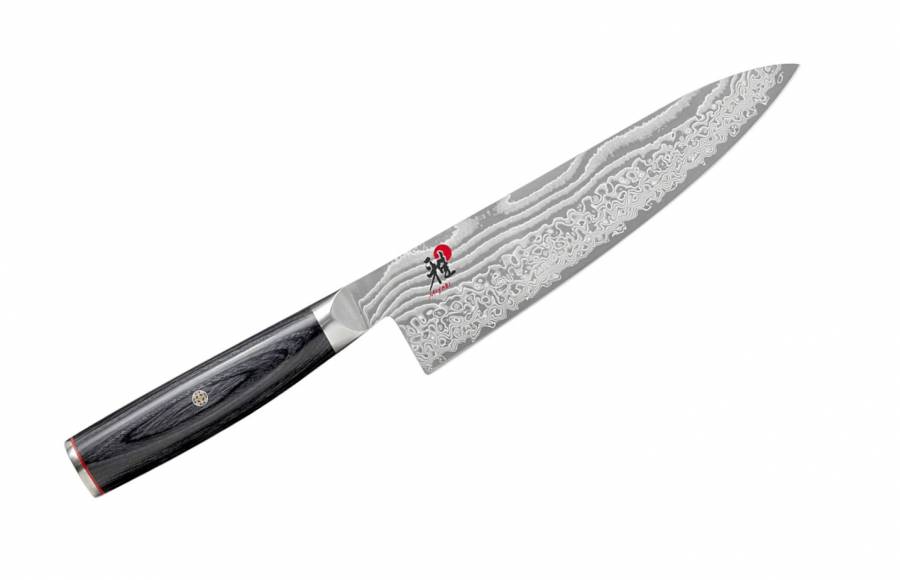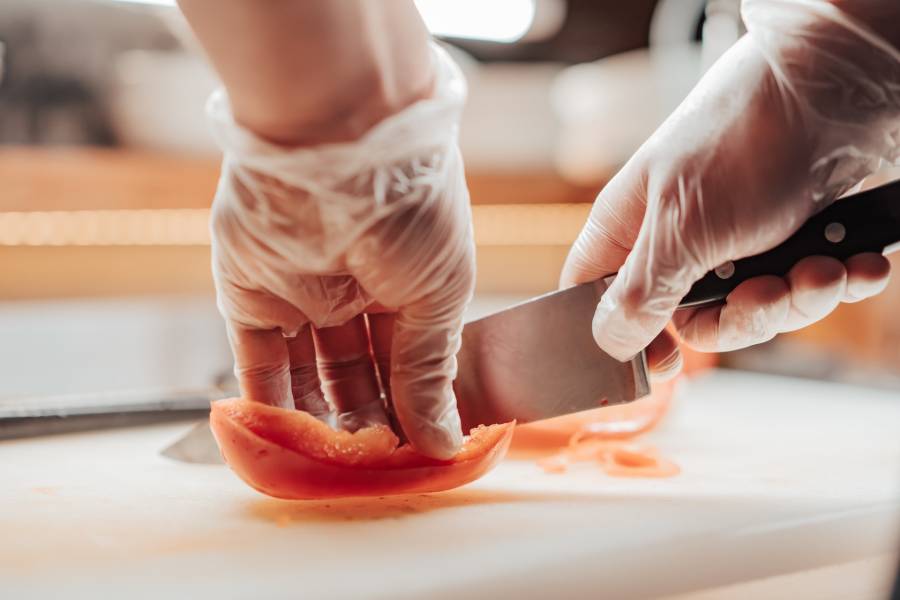No matter the knife’s task, be it slicing in a smooth motion or chopping tough vegetables and food items, a sharp blade makes it easy to do any slicing, dicing, or cutting jobs quickly.

The more complex the material, the faster it loses its sharpness.
In essence, kitchen counters, cutting boards, baking dishes, and plates made of glass, ceramic tiles, earthenware, and stone are unsuitable for cutting.
Since we possibly cannot avoid these materials sometimes, we need to know what to do when our Miyabi knives suddenly get dull.
Why Sharpen My Knife
Maintaining a sharp knife should be your prime concern for every Miyabi knife you own and use daily.
The primary function of the knife is to cut, and you require a sharp blade to carry out this responsibility effectively.
A blunt knife poses a danger to the user because more pressure must be exerted on it, so the knife can easily slip off in the wrong direction, which can cause a domestic accident.
Therefore, all blades must be kept sharp.
Miyabi knife sharpening is a way of maintaining the blade, saving money that could have been used to get a new one, and, most importantly, providing safety for the knife operator.
You tend to save time during food prep by sharpening the knife and making quick, clean slices. Also, you avoid crushing the foodstuffs you intend to cut when you apply pressure, as in the case of a blunt knife.
If it were to be broken, you should get a new one. However, it is blunt, so it needs to be sharpened.
Why bother to purchase a new one, increasing your expenses, when you can sharpen it?
The Tools You Will Need
Maintenance and Miyabi knife sharpening should only be done with professional tools because of the toughness of the steel and the smooth honed cutting edge.
The following are tools you will need during the Miyabi knives sharpening process:
- A vertically rotating sharpening stone
- A horizontally rotating sharpening stone
- A towel for cleaning the knife
- The sharpener returns the indentation and compression of the blade to its original position after it has been bent in various directions due to intensive use.
- A Leather stropping block
- A sharpening steel
The Three Processes
Many people know their Miyabi knives are dull and almost useless, and attention should be given to them.
While some people don’t have the time to sharpen them or are just too lazy to do so, others don’t know how to go about the Miyabi knife sharpening process.
No one can perform your tasks precisely as you would except yourself. However, the art of Miyabi knife sharpening is relatively easy to learn once you use the correct tools and are guided in the right way.
Executing the Miyabi knife sharpening alone gives you greater satisfaction and gets you the desired results.
The Sharpening Process
Below is an easy-to-follow detailed explanation of how to sharpen your knife:
Get Your Tools Ready
Gather all the tools you need to ensure a smooth flow of the sharpening process.
Get a vast space where you can set the tools down, ready for use at any time, and give you enough room to carry this operation out.
Setting Your Sharpener
First, be sure that your knife is clean and dry. Then, set your vertically rotating sharpening stone on a surface that will hold it firmly.
Hold the sharpener by slightly pressing down the surface with one hand.
Align Your Knife
With your other hand, place the knife in an upright position at 90 degrees into the required module at the heel.
The Sharpening Procedure
By applying slight pressure, slide the knife towards you from the heel to the tip, trying as much as possible to maintain the hand positions and the angles throughout the process. Do these 3 to 10 times.
Taking Care Of The Burr
You can clean the burr by swiping the knife from top left to bottom right on the edge of the whetstone. Put it under running water to clean it thoroughly, then wipe it with a towel.
The Honing Process
After the Miyabi knife sharpening, a delicate honing process is followed. Regular Honing of your knife will sustain its sharpness, realigning the cutting teeth.
Below is a detailed step on how to hone your knife:
- You can use a handy knife sharpener or sharpening steel to hone your knife. The handheld sharpener is easy to use. Just put the blade in the opening and carefully slide it for some time for effective sharpening. If you decide to use the sharpening steel, ensure it is harder than your knife. However, never hone an already sharpened knife.
- To use the sharpening steel, place it on a chopping board or countertop point down. For Miyabi knife sharpening, the angle between the steel and the blades should be around 9 to 12 degrees.
- Slide the knife across and down the sharpening steel, working your way from the heel to the tip. Then swap sides. The first few strokes should be harder, and then reduce the hardness for a remaining couple of strokes. Repeat 3-10 times, switching sides after each stroke.
If honing can no longer regenerate the cutting edge, it must be reground to incorporate a new edge by redoing a Miyabi knife sharpening process.

The Polishing Process
A stropping block made of leather is then used to polish the edge to create a scalpel-like sharpness. It results in an intensely sharp blade profile that cuts easily, smoothly, and finely, typical for a Miyabi knife.
Test For A Positive Result
By holding the knife’s edge under a good amount of bright light, you can test the state of its blades. The knife is dull if the light is reflected, displaying a shiny light on its supposed sharp edge.
An alternative way to tell if a knife is sharp is by using it to cut a tomato or slicing it through a sheet of paper. If the blade is sharp, it will swiftly cut through the soft flesh and tough skin without any struggle.
Another way is by using the blade to tap against your fingernails gently. If it bites in, then it’s sharp. Whereas if it slides or deflects, it is dull.
However, if you think you have not gotten the expected result, you can repeat the Miyabi knife sharpening process until it’s your desired result.
How Often Should I Do This?
You don’t have to wait for your Miyabi knife to get blunt before you sharpen it. The time to sharpen your knives depends massively on the rate at which you use them.
Whether you use it barely or on an average scale, it is advisable to sharpen it every three months.
You will quickly notice when the knife starts getting blunt by making a habit of sharpening your knife in your routine work.
Honing your knife with sharpening steel from time to time is an excellent way to maintain it. Chefs use their knives very often, and most of them sharpen them every few weeks.
However, they hold the effectiveness of their knives by using sharpening steel daily.
Conclusion
Even the finest Miyabi knives are not as hard as stone, glass, earthenware, and ceramic tile. One cut on any of these materials will rapidly reduce its effectiveness.
A smart move for more effectiveness while performing a Miyabi knife sharpening is to grease the rotating sharpening stone with sharpening oil.
Note that the speed of gliding is less important than the consistency of the stroke movement, the most important being the angle.
When the Miyabi knife is sharpened regularly, it’ll save you the experience of discouragement and frustration.
